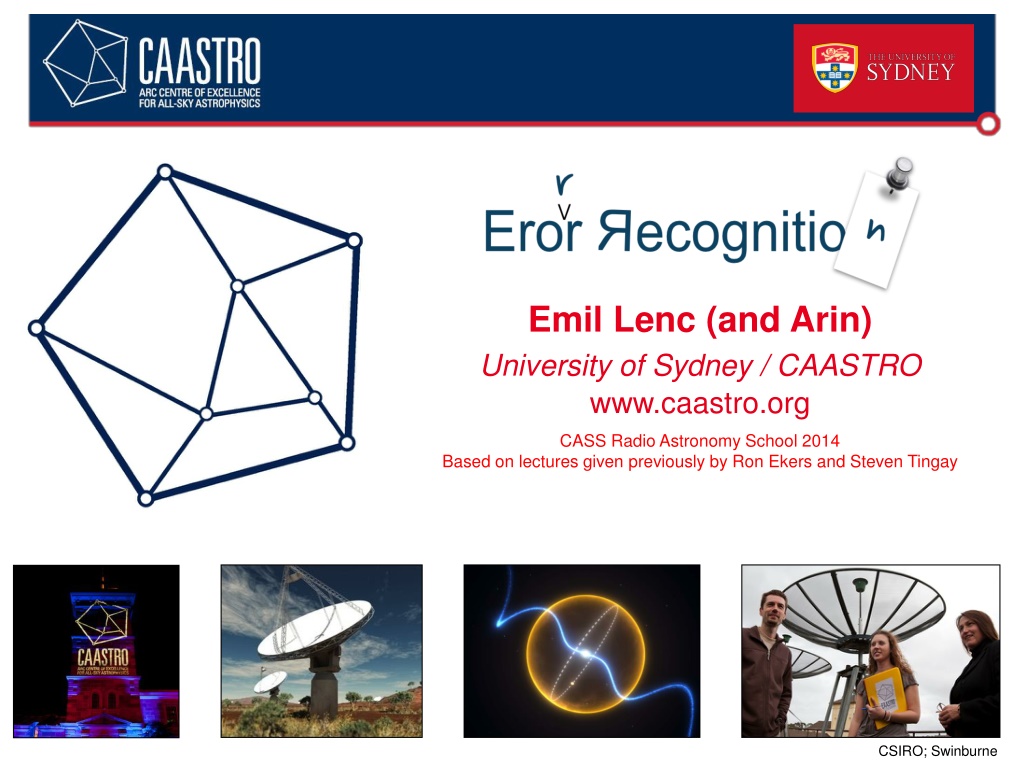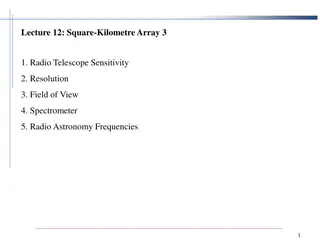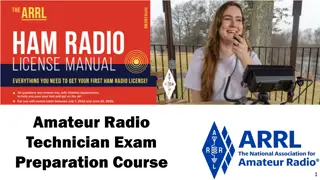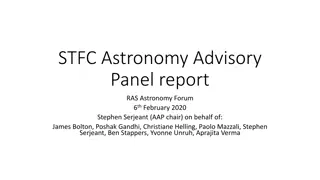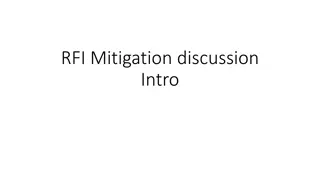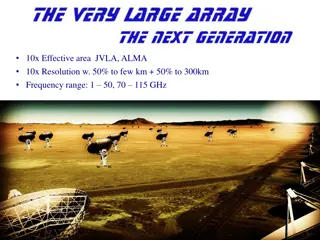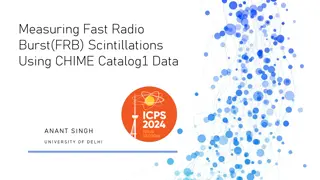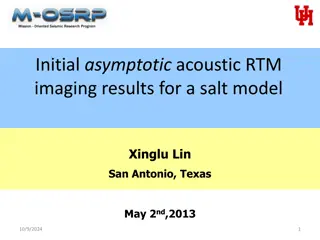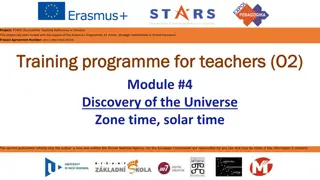Understanding Errors in Radio Astronomy Imaging
Errors in radio astronomy imaging can occur in the uv plane and image plane due to various factors such as measurement errors, calibration imperfections, and approximations made during processing. Different error types like additive, multiplicative, and convolutional errors impact the quality of astronomical images. Recognizing error patterns, diagnosing real vs. imaginary components, and understanding Fourier transform relations are crucial for accurate error correction in radio astronomy data processing.
Download Presentation

Please find below an Image/Link to download the presentation.
The content on the website is provided AS IS for your information and personal use only. It may not be sold, licensed, or shared on other websites without obtaining consent from the author. Download presentation by click this link. If you encounter any issues during the download, it is possible that the publisher has removed the file from their server.
E N D
Presentation Transcript
Error Recognition Emil Lenc (and Arin) University of Sydney / CAASTRO www.caastro.org CASS Radio Astronomy School 2014 Based on lectures given previously by Ron Ekers and Steven Tingay CSIRO; Swinburne
Error Recognition Some errors are easy to recognise Some are hard to fix Some are easy to fix
Where do errors occur? Most errors and defects occur in the uv plane - Measurement errors (imperfect calibration see Emil Lenc s Calibration and Editing talk). - Approximations made in the uv plane. - Approximations made in the transform to the image plane. Some are due to manipulations in the image plane. - Deconvolution (see Rick Perley s talk). What we usually care about are effects in the image plane (not always e.g. spectral line). The relative contribution of certain errors will vary depending on the nature of the observation.
Image or uv plane? We need to work between the uv plane and the image plane. - Different types of errors may be more obvious in one plane than the other. - A good understanding of the relationship between both planes helps (see John Dickey s talk on Fourier Transforms). Errors obey Fourier transform relations. - Narrow features transform to wide features and vice versa. - Symmetries important real/imaginary, odd/even, point/line/ring. - The transform of a serious error may not be serious! - Some effects are diluted by the number of other samples.
General form of errors Additive errors (out-of-field sources, RFI, cross-talk, baseline-based errors, noise) - V + I + F[ ] Multiplicative errors (uv-coverage effects, gain errors, atmospheric effects) - V I F[ ] Convolutional errors (primary beam effect, convolutional gridding) - V I F[ ] Other errors - Bandwidth and time average smearing. - Non-coplanar effects (see Wide Field Imaging talk by Martin Bell) - Deconvolutional errors (see Deconvolution talk by Rick Perley) - Software!!! (see everyone!)
Error Diagnosis If is pure real, then the form of the error in the uv plane is a real and even function i.e. F[ ] will be symmetric. - Such errors are often due to amplitude calibration errors. If has an imaginary component, then the form of the error in the uv plane is complex and odd i.e. F[ ] will be asymmetric. - Such errors are often due to phase calibration errors. Short duration errors - Localized in uv plane but distributed in image plane. - Narrow features in uv are extended in orthogonal direction in image. Long timescale errors - Ridge in uv plane causes corrugations in image plane - Ring in uvplane causes concentric Bessel rings in image plane
Gain Errors 10 deg phase error 20% amp error anti-symmetric ridges symmetric ridges Adapted from Myers 2002
Additive Errors: RFI Dirty Map PSF Observation of 1 Jy source
Finding RFI Observation of 1 Jy source See Mark s talk for more on removing RFI.
The Bigger Picture >6 deg!
Multiplicative Errors Dirty Map PSF
Primary Beam Error Common in widefield imaging/instruments Deconvolved Peeled Peeling applicable to transient and variable sources too.
Point Deconvolution Errors Pixel centred Pixel not centred
Deconvolution Errors (Large-scale Structure) True sky Standard CLEAN Standard CLEAN does not handle large-scale structure well results in negative bowls. More modern algorithms such as Multi-scale CLEAN are necessary to minimise deconvolution errors (see Rick Perley s talk).
Wideband Deconvolution Errors Dirty Image (2.1 GHz CABB Obs) PSF
Wideband Deconvolution Errors Deconvolved Image Standard CLEAN
Wideband Deconvolution Errors Source SED What standard CLEAN fits with
Wideband Deconvolution Errors Deconvolved Image Multi-frequency CLEAN (see Rick Perley s talk)
Missing short baselines No short baselines Paul Rayner 2001 Can only be fixed with additional data. See Shari s talk on observing strategies.
Smearing Errors Time-average smearing Averaging 1000s Bandwidth average smearing Average 512x1MHz band
Finding the errors in your way Avoid sausage factory processing (at least initially) - Try to understand each processing step. - Look closely at the data after each step, check and image calibrators. - Does the data look plausible. Take a different perspective - Look at your data in different domains (time, uv, image, frequency). - Plot different combinations of variables in different spaces. - Look at residuals, FT your dirty image, FT your beam. Process your data in different ways - Try different software, algorithms. - Partition and process your data in different ways - Try split in time chunks, split up frequency band - Different weighting, different uv tapers.
Error reduction Process Have errors been beaten to submission? Attempt to reduce effect of error Yes Determine greatest contributing error No Do Science
Whats happening? 5.5 GHz observation, 3 configurations, 2 GHz bandwidth 2000:1 dynamic range
Whats happening Amplitude calibration errors. Hot spot near edge of 4.5 GHz beam (outside 6.5 GHz beam) - Causes steepening of source spectra. - Causes position dependent effects. - Will need to consider peeling techniques. Spectral variation throughout the image (flat and steep) - Must use multi-frequency deconvolution. Structures on many different scales. - Must use appropriate deconvolution algorithms. North-west hot spot is bright and slightly extended. - Difficult to deconvolve accurately. - Small cell size or uv-subtract component.
Whats happening? 38,000:1 dynamic range
1. Can you deal with something new? What s happening? Low frequency MWA obs. A. Heat haze B. Antenna deformation C. Ionosphere D. Compression artifacts
2. Be daring in your search What s happening? A. Primary Beam error B. RFI C. Venetian blinds left open D. Deconvolution error
3. Can you work this out? What s happening? A. Amplitude errors B. Cosmic ray C. Bandwidth smearing D. RFI
4. Dare to solve this! What s happening? A. Amplitude errors B. Phase of moon incorrect C. Position-dependent errors D. Source outside imaged field
5. Dont give up! What s happening? A. RFI B. Bandwidth smearing C. Daylight savings not set D. Position-dependent errors
6. Are you able to solve this? What s happening? A. Amplitude errors B. Tartan from wrong clan C. Data stored in HEX D. Phase errors
7. A tricky problem What s happening? A. Missing short baselines B. Missing long baselines C. Missing astronomer D. Alien Resurrection
8. End of game question What s happening? A. Amplitude errors B. Phase errors C. Deconvolution errors D. Position-dep. errors E. Almost everything
Acknowledgements This talk is based on talks by: - Steven Tingay - Ron Ekers - ASP Conference Series Vol. 180, p.321 available online Special thanks to Arin Lenc for running the pop quiz.
